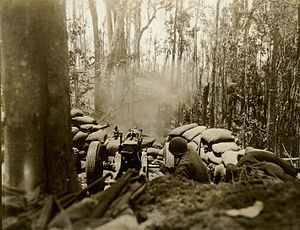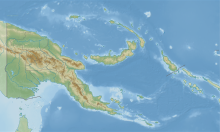
Back Gegenangriff auf Bougainville German Contre-attaque de Bougainville French Контрнаступление на Бугенвиле Russian Cuộc phản công Bougainville VI
| Bougainville counterattack | |||||||
|---|---|---|---|---|---|---|---|
| Part of the Bougainville campaign of the Pacific Theater (World War II) | |||||||
 A U.S. Army 75 mm pack howitzer firing at close range at a Japanese position on Hill 260 in March 1944 | |||||||
| |||||||
| Belligerents | |||||||
|
| |||||||
| Commanders and leaders | |||||||
|
|
| ||||||
| Units involved | |||||||
|
|
| ||||||
| Strength | |||||||
| 15,400–19,000 men | 62,000 men | ||||||
| Casualties and losses | |||||||
| 263 killed[2] | ||||||
Location within Papua New Guinea | |||||||
The Bougainville counterattack, also known as the Second Battle of Torokina,[3] was an unsuccessful Japanese offensive against the Allied base at Cape Torokina on Bougainville Island during the Pacific Theater of World War II. The Japanese attack began on 8 March 1944 after months of preparation and was repulsed by United States Army forces in fighting which lasted until 25 March. The attack was hampered by inaccurate intelligence and poor planning and was pushed back by the well-prepared Allied defenders, who greatly outnumbered the Japanese force. The Japanese suffered severe casualties, while Allied losses were light.
The goal of the offensive was to destroy the Allied beachhead, which accommodated three strategically important airfields. The Japanese mistakenly believed that their forces were about as large as the units deployed to defend the Allied positions. The Allies detected Japanese preparations for the attack shortly after they began in early 1944 and strengthened the base's defenses. None of the three Japanese forces which conducted the attack was able to penetrate far into the Allied perimeter, although there was intense fighting for several positions.
The Bougainville counterattack was the last major Japanese offensive in the Solomon Islands campaign. Following the engagement the Japanese force withdrew from the Empress Augusta Bay area, and only limited fighting took place until late 1944, when Australian troops took over from the Americans and began a series of advances across the island until the end of the war in August 1945.
